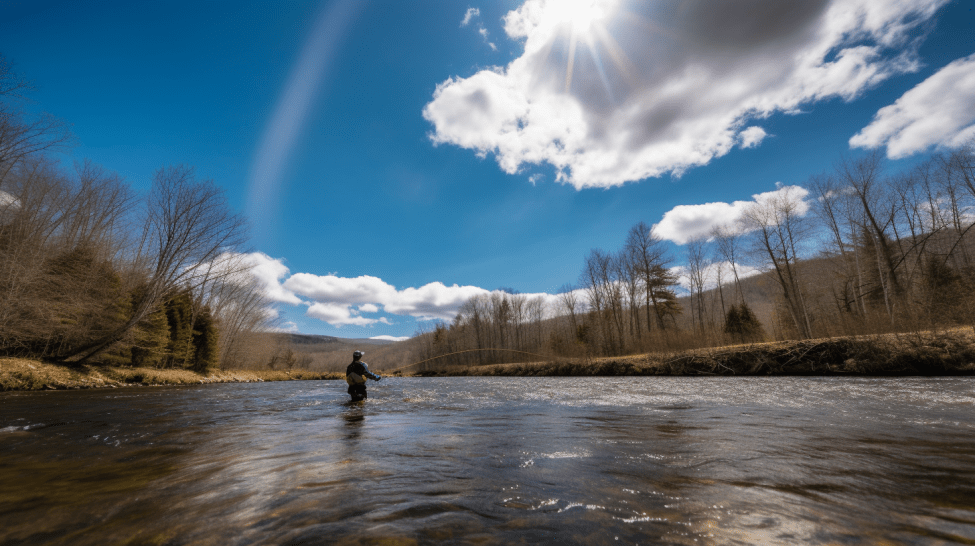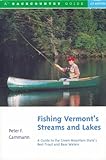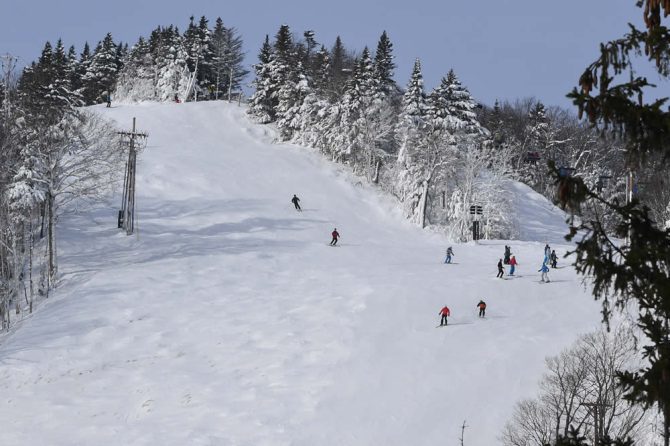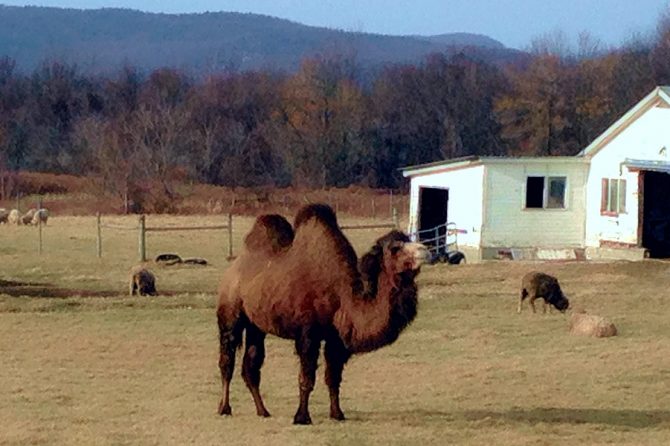Vermont is a great place for fly fishing! With its abundance of rivers and streams, it's no wonder why so many anglers come from all over the country to experience this amazing state. This guide will provide you with all the information you need to make your fly fishing trip to Vermont a success. We'll cover the best places to fish, the essential gear, techniques for catching trout, tips for avoiding mistakes, and where to get a fishing license. So, grab your rod and reel and get ready to cast your line in the beautiful waters of Vermont!
Best Destinations for Fly Fishing in Vermont
With its abundance of pristine lakes, rivers, and streams, Vermont offers an idyllic setting for anglers seeking a tranquil experience. The Green Mountain State is home to a variety of fishing opportunities, from brook trout in Lake Champlain to the expansive Lake Memphremagog in the north. The Connecticut River is a great spot for smallmouth bass, and the Winooski River is known for its trophy brown trout. Anglers who prefer to fly fish should head to Otter Creek for some of the best fly fishing in New England. Salmon and steelhead can be found in the Missisquoi River, and the Batten Kill is renowned for its trout population. Regardless of the species of fish you’re looking for, Vermont has something to offer every angler. With its secluded, picturesque landscapes, it’s easy to see why the Green Mountain State is a favorite among fly fishers.
Essential Gear for Fly Fishing
You must be equipped with the necessary gear for your fly fishing endeavor in the Green Mountain State. This gear consists of the fly rod, which is a lightweight rod specifically designed for casting and presenting the fly to the fish. Fly reels are also essential for fly fishing, as they allow the line to be reeled in and stored. Fly lines are also necessary, as they carry the leader and tippet that are used to present the fly to the fish. In addition to these components, other essential gear for fly fishing includes waders, a landing net, and polarized glasses for better visibility.
- You can get excited about the premium items
- The 64 pcs flies kit includes Mayfly dries, Streamers, Leeches, Wet Flies, Terrestrials, Miscellaneous dries, and Caddisfly dries in assorted sizes and (or) colors
- Please refer to the pictures for the detailed fly patterns and sizes
- The flies come loaded in a quality fly box with secure magnetic fastener for quick opening and closing
- The flies included in this kit are the perfect tools for the job and are sure to get some attention, whether you’re targeting bass, panfish, trout, or steelhead
- MODERATE ACTION: The 8-foot 3-piece fly fishing rod combo provides a moderate action, making it ideal for catching light and medium species from panfish to trout, walleye, bass and more
- EXPERTLY CRAFTED MATERIALS: Durable 5/6 weight fiberglass rod blank construction that holds a 4-6 LT6F line weight and comes with a comfortable EVA rod handle that provides all-day comfort and a sure-grip
- DURABLE & LIGHTWEIGHT: This size 5/6 single action fly fishing reel with rim control comes fully loaded and pre-spooled with 6 weight floating premium fly line, backing and leader. The reel has a line capacity of 30-yards LT6F, and backing capacity of 50/20 yds/lbs. It features a durable aluminum frame, lightweight aluminum spool, a metal clicker with an on/off control and push-button release
- 6-PIECE TACKLE KIT: This custom fly tackle assortment includes 6 pieces of fly tackle, and includes a scannable barcode linking to a getting started guide so all fly fishing enthusiasts can learn how to cast, tie knots, and care for your equipment
- TRUSTED: Since 1949, Zebco has been inviting people to explore the outdoors. Zebco products are warranted for a period of (1) year from date of original retail purchase against defects in workmanship and/or materials
- Longest lasting dry fly floatant on the market.
- The special formula has proven effective on the water across the USA.
- Easy on the fly, allowing it to move naturally through the water.
- Safe for the environment
- Made in the USA
- [Catch and Release Net]: The rubber mesh with small holes protect little native trout if the fish is too small, it will slip through the holes. Soft and smooth mesh holes are very gentle to fish and will not damage their delicate natural slime.
- [Soft & Clear Rubber Net]: The trout fishing net is made from high quality rubber mesh. Soft net will not harm fish. Transparent rubber mesh virtually disappears underwater, won't spook fish.
- [Durable Wooden Handle]: The frame and handle are made from laminated bamboo and hardwood, smooth, comfortable and easy to grip. The wooden surface has special coating, waterproof and resistant to abrasion.
- [Classic Teardrop Design]: Wooden handle measures 21.5 cm, hoop is 42 x 24.8 x 25 (cm). Best perfect nets for fishing on your favorite river, lake, or stream.
- [Anti-lost & Portable]: This flying fishing net attached with a safety cord to avoid losing, portable to hang on your back and waist, easy to catch and release when trout fishing. It is very convenient to carry while fishing.
- The Squirmy Wormy is an effective and productive fly-fishing pattern that immitates a squiggly, juicy worm. This worm pattern is an excellent fly for many freshwater fish including Bluegill, Bass, Brown Trout, Rainbow Trout, Greyling, Crappie and Panfish.
- This fly pattern catches fish like no other. It is perhaps one of the most dependible patterns and often produces fish when other patterns fail.
- The soft, stretchy, rubbery material wiggles in the water and creates life-like movement. Seriously, what fish does not love a nice squirmy worm?
- Aquatic worms are a common food source for many fish, so it is no surprise that the Squirmy Worm is an effective pattern. It is especially effective for trout, panfish, and bass.
- The weighted bead helps get the worm down deep where fish are feeding. To fish the squirmy worm, first let it drop. Then twitch the worm, wait a few seconds, and repeat. If the fish are biting, then it is sure to catch their attention. Another option is to fish it in a dropper combination or under an indicator. Whatever you choose, the Squirmy Wormy is sure to become a staple in your fly box.
- Rosenbauer, Tom (Author)
- English (Publication Language)
- 408 Pages – 05/01/2017 (Publication Date) – Lyons Press (Publisher)
- Dimension: 1 1/2″ long x 1 1/2″ wide x 1/4″ tall
- Weight: 1.5 OZ
- Magnetic Fly Patch holds flies, tools, lures, and anything else made of steel!
- keep barbless hooks from falling out of your traditional fly patch
- Made in USA!!
- Sold with one spool each of 2X, 3X, 4X, 5X and 6X Powerflex tippet
- Secure, spring-loaded pull for access to change spools
- Rotatable razorblade line cutter
- Quick snap is Made of high carbon stainless steel, these fly hook snaps are rust-resistant and durable.
- Its lighter and strong, suitable for hanging hooks and other fishing terminal tackle tools. provide fast, easy and secure change in just seconds. Save your time and also your tippet! These are very handy, you can give them to your fly fishing friends as a gift.
- 200pc 5 sizes combo, each size 40pc.
- Size: XS, S, M, L, XL. XS, length: 0.23inch / 5.8mm. S, length: 0.28inch / 7mm. M, length: 0.32inch /8mm. L, length: 0.36inch / 9mm. XL, length: 0.43inch / 11mm.
- Fly fishing knot cards with step-by-step, color-coded knot tying diagrams designed to be easy to follow, including descriptions and usage tips
- Includes mini carabiner for clipping your knot cards to your pack or vest
- Contains fly fishing setup diagram and clearly shows how to tie 14 essential fly fishing knots
- Portable, durable, completely waterproof card format is perfect for using in the wet environments encountered when fishing
- Fly fishing knots pocket guide is printed on super thick premium plastic card stock for unmatched durability — these things are designed to last
In order for the fly fishing experience to be successful, you must also have the right flies and lures. Flies are used to imitate the insects and other food sources that fish feed on, and they come in many different patterns and colors. Lures are often used to draw the attention of fish, and they can be made of metal, plastic, or feathers. Lastly, it is also important to have a fly box to store and organize all of your gear. With the right gear and equipment, you can be sure to have an enjoyable and successful fly fishing experience in Vermont.
Techniques for Catching Trout
To catch trout, you'll need to know the right techniques. Fly fishing for trout is a popular activity in Vermont, and mastering the techniques will help you land a good catch. One technique is to cast upstream and allow the current to carry your fly downstream. This is a great method for fishing in fast-moving rivers. It's important to cast upstream of where you think the trout are so the fly can pass over them without spooking them. When the fly has passed them, you can start to retrieve it by slowly retrieving the line.
- Used Book in Good Condition
- Deitrich, Jeff (Author)
- English (Publication Language)
- 96 Pages – 12/01/2003 (Publication Date) – Stackpole Books (Publisher)
- Miller, Don (Author)
- English (Publication Language)
- 182 Pages – 11/24/2014 (Publication Date) – CreateSpace Independent Publishing Platform (Publisher)
- Amazon Kindle Edition
- Daniels, Patrick (Author)
- English (Publication Language)
- 13 Pages – 06/02/2015 (Publication Date)
- Underwood, Lamar (Author)
- English (Publication Language)
- 176 Pages – 04/14/2015 (Publication Date) – Skyhorse (Publisher)
Another technique is to use a still water approach. This is especially effective in stillwater lakes or ponds. Cast your fly in the direction of where you think the trout are located, and then let it sit for a few seconds. You can then slowly retrieve it and repeat this method. This will help you cover more of the water and gives the trout more time to find your fly. You can also experiment with different types of retrieves and depths to see what works best. With these techniques, you'll be sure to have a successful day of fly fishing in Vermont.
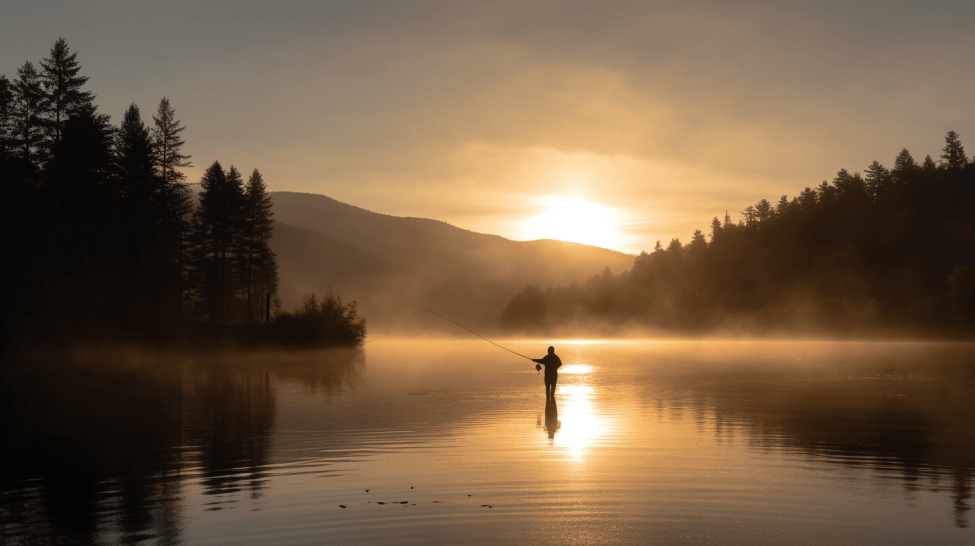
Fly Fishing in Vermont: Tips on Avoiding Common Mistakes
When fly fishing for trout, it's important to be aware of common mistakes in order to ensure a successful day. One of the most common mistakes is not properly setting the hook. When a fish bites, it's important to react quickly with a firm, but not overly aggressive, hook set. If the hook isn't set properly, the trout may be able to shake it off and the angler will miss out on a catch. It's also important not to pull too hard on the line during the hook set, as this can damage the fish's mouth.
Another common mistake is not using the right type of fly. Different species of trout prefer different types of flies, so it's important to research which flies will work best in the specific area. Not using the right type of fly can result in not having any bites. Additionally, it's important to take into account the time of year and the weather when deciding which type of fly to use. The wrong type of fly can lead to a disappointing day on the water.
Where to Get a Fishing License in Vermont
Getting a fishing license is an important part of fly fishing, and acquiring one can be hassle-free and enjoyable. Fishing licenses can be acquired from a variety of sources in the state of Vermont, such as local bait and tackle shops, sporting goods stores, and government offices. The Vermont Fish and Wildlife Department's website is a great source for information on how to obtain a fishing license. Most licenses can be purchased online, making the process even more convenient.
- Used Book in Good Condition
- Cammann, Peter F. (Author)
- English (Publication Language)
- 206 Pages – 10/17/1992 (Publication Date) – Countryman Press (Publisher)
- Traver, Tim (Author)
- English (Publication Language)
- 240 Pages – 03/09/2020 (Publication Date) – The History Press (Publisher)
- Hardcover Book
- English (Publication Language)
- 320 Pages – Vermont Dept. of Fish and Wild (Publisher)
- Desjarlais, Luc (Author)
- English (Publication Language)
- 254 Pages – 11/09/2018 (Publication Date) – Luc Desjarlais (Publisher)
- Amazon Kindle Edition
- Zambello, Lou (Author)
- English (Publication Language)
- 709 Pages – 08/15/2016 (Publication Date) – Wilderness Adventures Press (Publisher)
For residents of Vermont, fishing licenses are valid for one year from the date of purchase. For non-residents, there are a variety of short-term and multi-day licenses available, depending on the type of fishing they intend to do. If you are unsure of the regulations and the type of license you need, the Vermont Fish and Wildlife Department can provide helpful guidance. It is always important to check the regulations to make sure you are following the rules and regulations of the state when fishing.
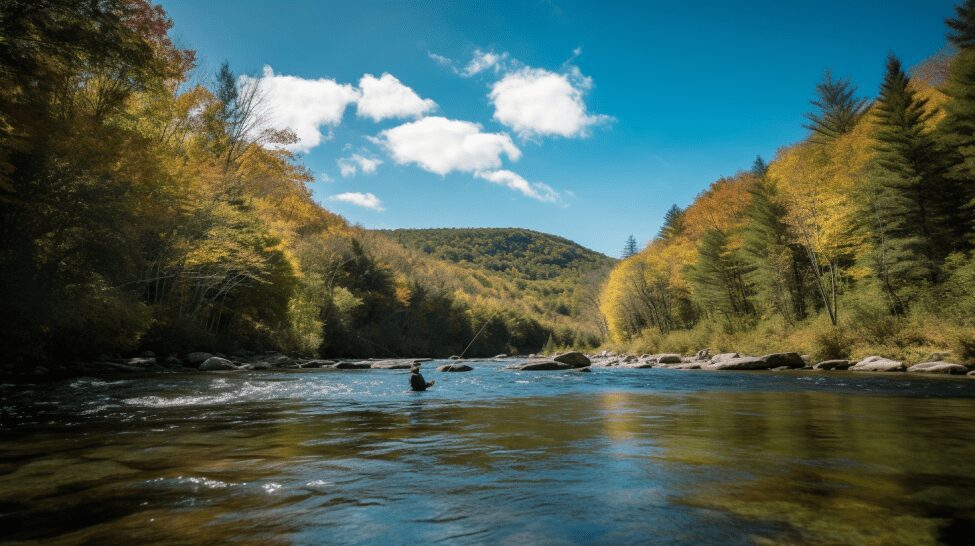
Frequently Asked Questions
What is the best time of year to go fly fishing in Vermont?
Fly fishing in Vermont is best suited for the warmer months of the year, typically from late spring through early fall. The combination of rising water temperatures and increased insect activity make these months the most productive for anglers. Summer is especially popular, as the extended daylight hours make it easier to stay out on the water for longer periods of time. However, experienced anglers know that the cooler months of the year can still be productive and often provide a more peaceful and private experience.
How much does it cost to rent fly fishing equipment in Vermont?
Fly fishing in Vermont can be a great experience, but it can also be expensive. Renting fly fishing equipment can be costly, with prices ranging from $20 to $50 per day. The cost of renting equipment can vary depending on the type of gear you need and the length of your rental. It's important to do your research and shop around to find the best deal.
Is it possible to go fly fishing in Vermont without a fishing license?
Fly fishing in Vermont does require a fishing license for all anglers age 15 or older. Non-residents and residents are required to have a valid license to legally fish any water in Vermont. That being said, there are a few exceptions. For example, if you are fishing on a licensed fishing preserve, a license is not required. Additionally, any person under 15 years of age who is accompanied by a properly licensed adult may fish without a license.
What type of clothing should I wear while fly fishing in Vermont?
When going fly fishing in Vermont, it is important to wear clothing that will keep you warm and dry. Layering is key, so opt for a combination of a wicking base layer such as a long-sleeved shirt, a mid-layer such as a fleece or wool sweater, and a waterproof outer layer such as a rain jacket. You'll also want to wear a hat, gloves, and waterproof boots to protect yourself from the elements. Additionally, bright colors are a good idea to make sure you stay visible, as well as to help you spot fish in the water.
- LIGHTWEIGHT CONSTRUCTION to hold all your essential trout fishing gear, combining the breathability of mesh with the durability of 100% recycled ripstop polyester
- EIGHT POCKETS, four zipper and four Hook and Loop, with plenty of capacity for your fishing essentials and fly tying tools
- TWO FLY-DRYING PATCHES placed high up on the chest for safekeeping and easy accessibility
- RUBBERIZED TABS FOR TOOL DOCKING to keep your fishing pliers and forceps handy
- ELASTIC LOOPS FOR EASY TIPPET BAR ATTACHMENT with elastic loops that hold your spools front and center within easy reach
- Chest and waist high convertible with waist-mounted ease-lock suspenders
- Elastic adjustable suspenders for maximum comfort; Adjustable, 2-inch wide belt with quick-release buckle and utility loops for gear attachment
- Large chest storage pocket with YKK waterproof zipper closure; Reach-through fleece hand warmer pocket with YKK waterproof zippers; Interior chest zippered pocket flips out for easy access; Velcro on chest to attach a fly patch (not included)
- Articulated knee; Self-fabric gravel guard with gathered elastic bottom hem; Anatomically engineered rubber boot feet
- Every pair of waders is tank tested for maximum performance – Designed to protect itself from water in the sea, in lakes, rivers, marshes; Repair kit is included
- UPDATED, VALUE-PRICED, FULL FEATURE MENS WADERS boast full toes-to-chest waterproof protection with a breathable nylon shell over polyurethane membrane over nylon tricot liner
- EXTERNAL ZIP STORAGE POCKET with stretch panel holds your phone and valuables safe and dry, easy to reach at the chest
- KANGAROO-STYLE HANDWARMER POCKET keeps you comfortable on cold mornings headed out to your favorite fishing spot
- WADING BELT with opposing side-release buckles give these chest waders easy waist-high conversion on warm days; MODERN FIT designed specifically for a man’s body eliminates traditional wader bulk
- ORVIS IS DEDICATED to high-quality, comfortable clothing and fly fishing accessories to help you embrace the outdoors, and these Clearwater Men’s Waders (2TZX) are the perfect waterproof yet breathable waders for your next fly fishing adventure
- ☀️ 7 Total Pockets: Dual right leg fishing tackle pockets lined with wear-resistant plastic nylon, so you will have a place for everything such as pliers, scissors, knives.(These tools are not included in the package). Two slash hand pockets, two rear zipper cargo pockets, one left leg zipper cargo pocket, all three of these large zippered pockets keep your essentials safe and quickly accessible
- ☀️ Water Repellent: You can't fish on the water for long when you are wet and cold. To stay dry, you need a pair of water-repellent shorts. Our MythIce fabric repels water, keeping you dry and agile, and it also repels moisture and dries quickly—avoiding stains and keeping you clean
- ☀️ Performance Fishing Short: MythIce 4-WAY stretch fabric shields your skin from harmful UV rays with UPF 50+ sun protection, properties to minimize odor and outstanding wicking performance for important moisture management. MythIceis a technology that creates a strong cooling effect when coming in contact with sweat, it's cooler than most shorts you've ever worn
- ☀️ Flexible & Breathable: Features an adjustable hidden waistband to keep you comfortable on the water all day. Perforated back yoke for maximum breathability, gusseted crotch for maximum mobility; You’ll never want to fish without this multi-purpose fishing short again. Different fishes are embroidered on different colored shorts belt loops and you are unique on the water
- ☀️ Multi-Purpose Fishing Short: Suitable for daily wear, hiking, hunting, travelling, camping, great for inshore, offshore, freshwater, and saltwater fishing, fly fishing and lure fishing. It’s a great gift for fisherman, angler or anyone who loves fishing
Are there any regulations regarding the size of fish I can catch in Vermont?
When fly fishing in Vermont, it is important to know and follow the regulations regarding the size of fish you can catch. Generally, trout and salmon must measure at least 15 inches before they can be legally caught. Other species, such as bass, need to be at least 12 inches. If you catch a fish that is below these sizes, you must return it back to the water unharmed. It is important to be aware of these regulations, as there are hefty fines for anyone who is found to be breaking them.
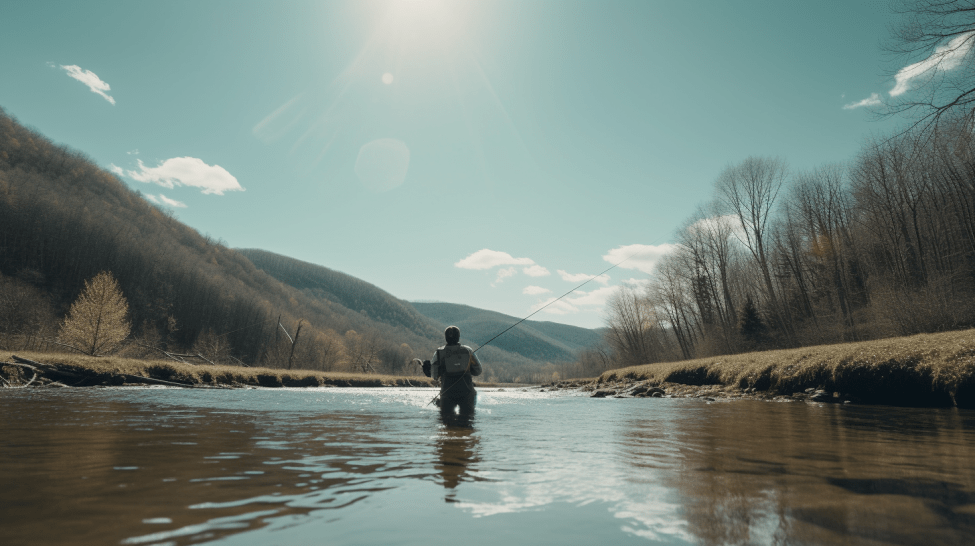
Conclusion
Fly fishing in Vermont is an exciting and rewarding experience. With the right gear, knowledge, and techniques, you can have a successful fishing trip in Vermont. When you’re out on the water, remember to be mindful of the environment and be respectful of the fish and other wildlife. Also, make sure to get the proper fishing licenses before hitting the water. Don’t forget to have fun and enjoy the beauty of Vermont from the river banks. With the right preparation and knowledge, you can have an unforgettable fly fishing experience in Vermont.
Thank you for reading this post, don't forget to subscribe to our email list for the latest news!


